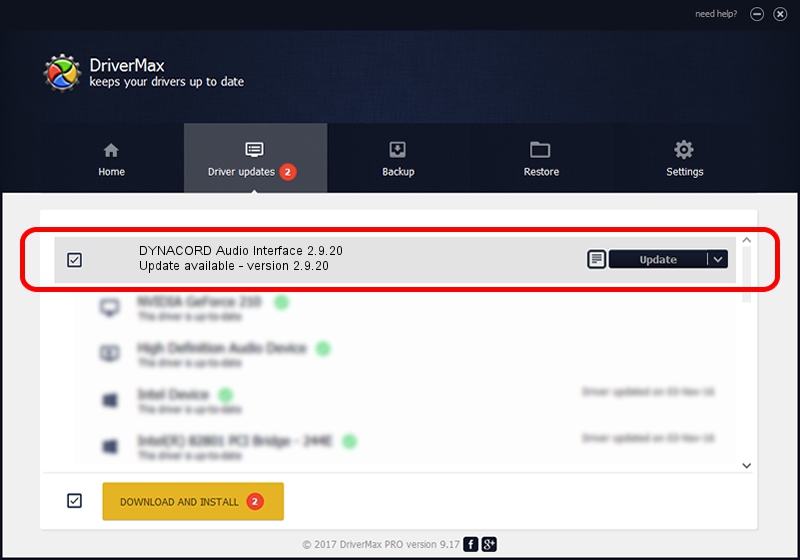Dynacord Usb Audio Driver
Louis shows you how to record audio with a USB mixing console. If you want to buy a mixer like this please. Installing the USB driver. 1 DVD with USB driver, documentation, software. Lect the PowerMate (DYNACORD USB-AUDIO) as the play- back device.
MIC/LINE Input Channels The XLR microphone input is equipped with an extremely high quality, ultra-low noise, discrete preamp. The +48V phantom power for condenser microphones can be switched in groups of six. The Line Input and Channel Insert are implemented as jack sockets. The Gain can be controlled in the range 0-60 dB. The switchable Lo Cut filter (80Hz, 18dB/oct.) serves to eliminate low-frequency noise. A very typical DYNACORD feature is the asymmetrical Voicing Filter by means of which, if desired, the voice can be powerfully emphasized in the mix.
Optimized for ease-of-use, the 3-band semi-parametric equalizer makes it possible even for unpracticed users to perform the requisite corrections swiftly and intuitively. With their extended buss structures, the CMS3 mixers offer very flexible configuration options. In all, 6 AUX busses are available in each case: 2 (FX) are assiged to the two effects devices; 2 (AUX) can be configured either as monitor or effects sends by means of a switch in the Main section; 2 (MON) are designed as monitor sends, each being equipped with a sweepable anti-feedback filter in the Master section.
MUTE and PFL switches, each with its own LED, make it possible to mute each input channel individually and/or listen to its pre-fader signal. Each channel offers a Signal Present and Peak LED for level control. The channel faders are dust-protected and offer not only excellent crosstalk attenuation but also a practice-optimized control characteristic. Sn gen microsoft imei skachatj. All potentiometers and faders are high-quality components from ALPS.
Stereo MIC/LINE Input Channels The stereo input channels are equipped in much the same way, but optimized, naturally, to carry stereo signals. Two of the four stereo inputs of each model are additionally equipped with cinch (RCA) sockets switched in parallel for CD or MP3 players. The two other stereo inputs receive in addition the four channels of the digital audio interface USB 1-2 and USB 3-4 Separate Gain controls are provided for the Stereo Line and Mic inputs to permit them to be used in parallel if desired. Three-band tone controls are provided, and a Balance control replaces the PAN control found in the mono channel strips. MASTER In the Master Section, too, the CMS3 mixers are lavishly equipped.
The 11-band stereo equalizer can be routed to the Master channels or else to either or both of the Monitor Sends according to choice. The FX1+2 Returns as well as the AUX1+2 and MON1+2 Sends are on faders just like the Master L/R signal, which makes for comfortable and intuitive operation. The Master B signal is available pre or post MASTER L/R fader and can be mono-summed if desired. The Master signal is also available on the REC Send cinch (RCA) output with level control. The level meters of the CMS3 comprise two LED chains of 12 LEDs each. The display range covers 40 dB; what is shown is the level in dBu at the master outputs.
When the PFL switch is activated, the left-hand LED chain shows the internal level of the master buss in dBu. The Standby switch mutes all channels e.g. During pauses, with only the 2TRACK-to-Master input remaining active for the playback of interval music. A 4-pin XLR socket is provided for the connection of a standard 12V/5W gooseneck lamp. DIGITAL USB 2.0 AUDIO INTERFACE The USB 2.0 port serves as a digital audio interface between the CMS3 and a PC or Mac. Four channels can be transmitted in either direction simultaneously. This interface can therefore be used either for the input of audio signals (e.g.

For playback or interval music) or else for live- or studio-recording applications. It is configured by selecting the relevant setting in the menu. For the use of the CMS3 with a PC or Mac, a free Cubase LE license as well as the requisite USB drivers are included free-of-charge on the supplied DVD. PC MIDI Interface The CMS3 also offers a fully-featured PC MIDI interface. The MIDI input also supports the remote switching of both internal effects units using a master keyboard or MIDI footswitch.
Professional Effects, OLED Display and Processing Menus The CMS3 has two integrated stereo multi-effects processors that work independently of one another, each offering 100 effects algorithms optimized for live performance, the most important parameters of which are editable. Linear 24-bit AD/DA converters and 48-bit double-precision processing guarantee the finest studio quality based on state-of-the-art technology. The 100 program locations of each device are packed with high-quality reverbs, halls and plates that deliver professional results in live performance on stage as well as in both studio and home recording environments. Other presets include Echo/Reverb and Chorus/Echo combinations, a variety of delay, flanger, chorus and doubling algorithms, as well as special reverb and delay programs. When a delay effect is active, the delay time can be synchronized to the beat of the music using the TAP key. Edited effects programs can be stored in the 20 User memories offered by each device, assigned names, and later selected and used in the same way as the presets. The large, high-contrast OLED display is easily read from a wide range of viewing angles—even in very bright surroundings.
